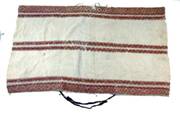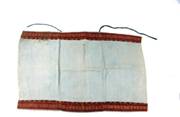|
Every Checkpoint of the Life Stages—Rites of Passage |
|
Tags: aborigine | culture | rites of passage
“From cradle to grave”is the process of life. Whether it's the anticipation for birth, the respect for death, the blessing of marriage or the desire for adulthood, all these stages make human society exceptionally value each of life's milestones. Reaching a milestone can indicate a shift in social role, physical or emotional state. Such achievements may challenge us with new responsibilities or even bring joy. To bestow significant meanings upon these life stages, nearly every ethnic group has generated rites of passage in order to mark the change and to help members adjust. Therefore, the Rukai's and weeping-wedding, the Paiwan's funeral cloth and the Ami's initiation into adulthood, or in the southwestern area of China the funeral feast of the Hmong, the Dai's and the Qiang's wizardry dance all reveal the respect and inheritance of every ethnic group for rites of passage.
The contemporary Dutch scholar A.van Gennep in his book Les rites de passage defined “rites of passage” as “rites that are held when someone's social status changes from one to another.” As a result, the establishment of “rites of passage” is based on the respect for life and renders folks rules to abide by when facing the transitions of life. Although many arbitrary rites have lost its origins, but undoubtedly, these rites indeed affect our everyday life. Through the display of the imagery distinguished collections in the Joint Catalogue of Digital Archives, we can understand every kind of rites of these ethnic groups in their face of the transitions of life. And from each of their activities we can reflect again on the meaning of life and the esteem for life.
人類學主題小組
Every Checkpoint of the Life Stages—Rites of Passage (Related Collections)

Bygone name: feathered embellishment
- Theme and key words: ethnic group: Amis
- Explanation: Purpose of the period piece: the big feathered crown “takaku” worn by the youth in their puberty rites. The meaning of wearing the white feather on the head is “I respect Mom.” The behavior of placing Mom at the highest place shows “My love for The Sun Mother.” The two pieces of red cloth fixed on two sides of the throne with white feather on them drape in front of the chest. They are called “marai” and served as an embellishment. People think the two pieces the most beautiful when they flutter with the dancer's body movement. Description: the big feathered throne “takaku” worn by the youth in their puberty rites was made of the two white feathers in Taiwanese Lophura swinhoii(tounkaang)'s tail. Due to the decreasing number of this kind of bird, the “takaku” feathered throne was later made of white feathers from other kinds of imported birds. The white feather is symbolic of rays of the sun since the Amis consider rays of the sun white. The meaning of wearing the white feather on the head is “I respect Mom.” The behavior of placing Mom at the highest place shows “My love for The Sun Mother.” The two pieces of red cloth fixed on two sides of the throne with white feather on them drape in front of the chest. They are called “marai” and served as an embellishment. People think the two pieces the most beautiful when they flutter with the dancer's body movement.
- Data ID: Number: 3278

- Theme and key words: ethnic group:Rukai
- Explanation: Purpose of the period piece: used as cloth to keep warm or as a betrothal gift. Description: The leather coat is made of skins of the hunted goat, leopard or monkey. When making the leather coat, people flay skins of the hunted animals stated above, pierce four branchlets through the four sides of the beasts’ skin, flatten it, dry it by sun heat and then rub it with a kind of bark material until it becomes soft. The fur on the skin of goats and deer has to be shaved, but that on the skin of leopards and monkeys don't have to. The leather coat made of the hunted leopard can be worn by no one but the hunter himself, and it is the deference and highest honor given by the group members. Texture: deer skin. Manufacturing technique: cutting and sewing.
- Data ID: number: 3586

- Theme and key words: ethnic group: Rukai
- Explanation: Purpose of the period piece: used by the chieftain to drink in The Harvest Ceremony, weddings, festivals, hunter-awarding, or the feast. Description: Whether it has carven lines on itself, the single cup of Rukai is mostly diamond-shaped and is reserved for the use of the chieftain's drinking during special ceremonies or rites. When the chieftain drinks with other people, a designator will have to pour wine into the single cup and place it before the chieftain. Texture: wood. Manufacturing technique: chopping and whittling.
- Data ID: number: 3612

- Theme and key words: ethnic group: Paiwan
- Explanation: Purpose of the period piece: civilians’ weeds. Description: In society of Paiwan a lot of taboos are imposed on families with deceased members. They can't laugh when talking, lower their heads when walking or join any pageantry. Wearing weeds distinguishes them from others and reminds them to show some restraint. Texture: cotton and stitches. Manufacturing technique: weaving, sewing and stitching.
- Data ID: number: 3145

- Theme and key words: ethnic group: Paiwan
- Explanation: Purpose of the period piece: worn on the head in a funeral.
- Data ID: number: 3151

- Theme and key words: ethnic group: Paiwan
- Explanation: Purpose of the period piece: chieftains’ weeds.
- Data ID: number: 3153

- Theme and key words: ethnic group: Paiwan
- Explanation: Purpose of the period piece: worn on the head in a funeral.
- Data ID: number: 3156

- Theme and key words: ethnic group: Paiwan
- Explanation: Purpose of the period piece: The linked cup is often used as drinking utensils in feasts or festival rites such as The Harvest Ceremony, weddings, hunter-awarding, and so on. It was a special custom of the Paiwan Tribe for maintaining amity that two people held the cup to drink millet wine together. Description: The linked cup is used in reception for special guests, significant rituals, weddings and reconciliation reached between people. It can not be used at one's will and has to be used under the approval given by the seniors on the scene. Texture: wood. Manufacturing technique: chopping, whittling and carving.
- Data ID: number: 3195
|



















